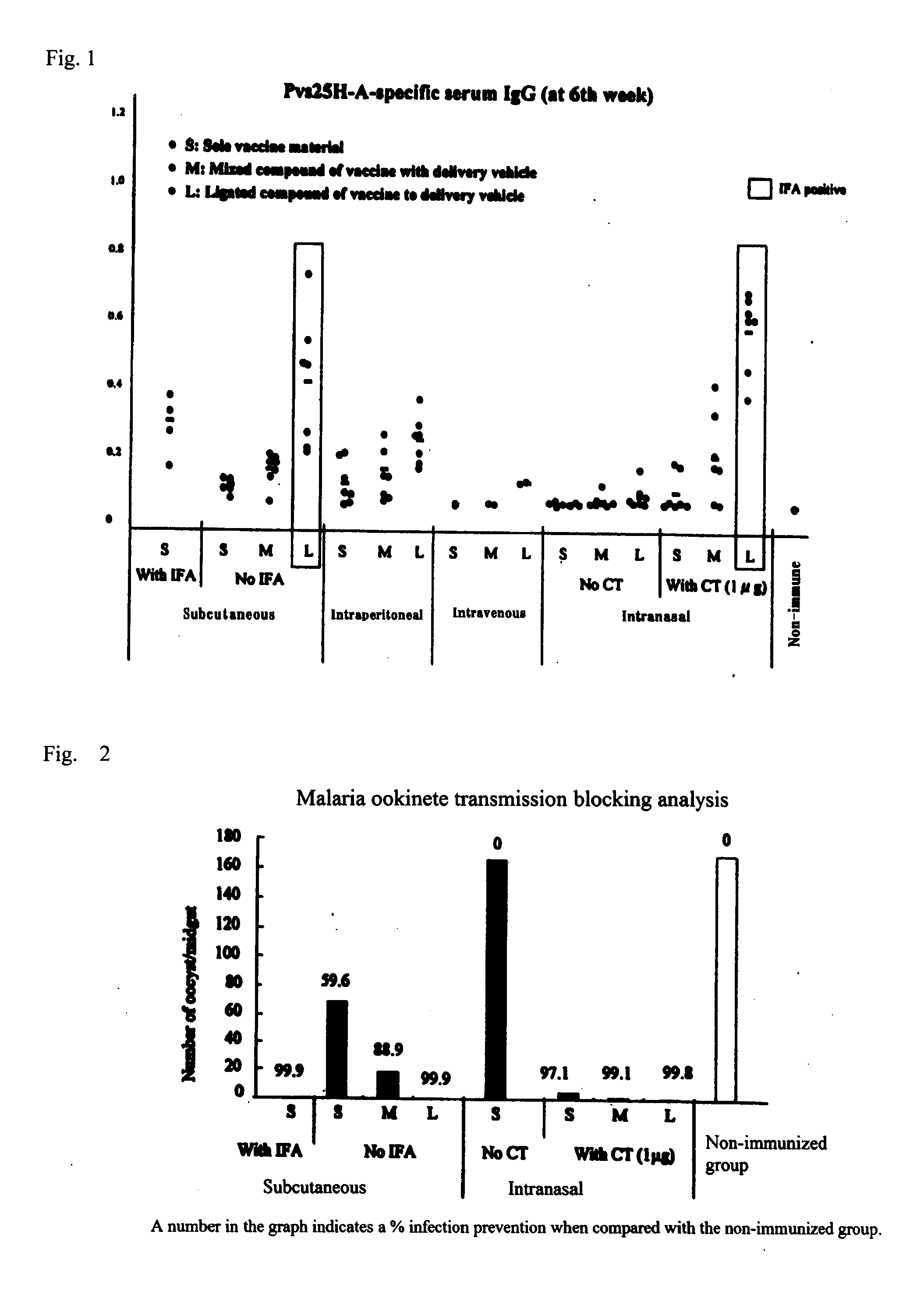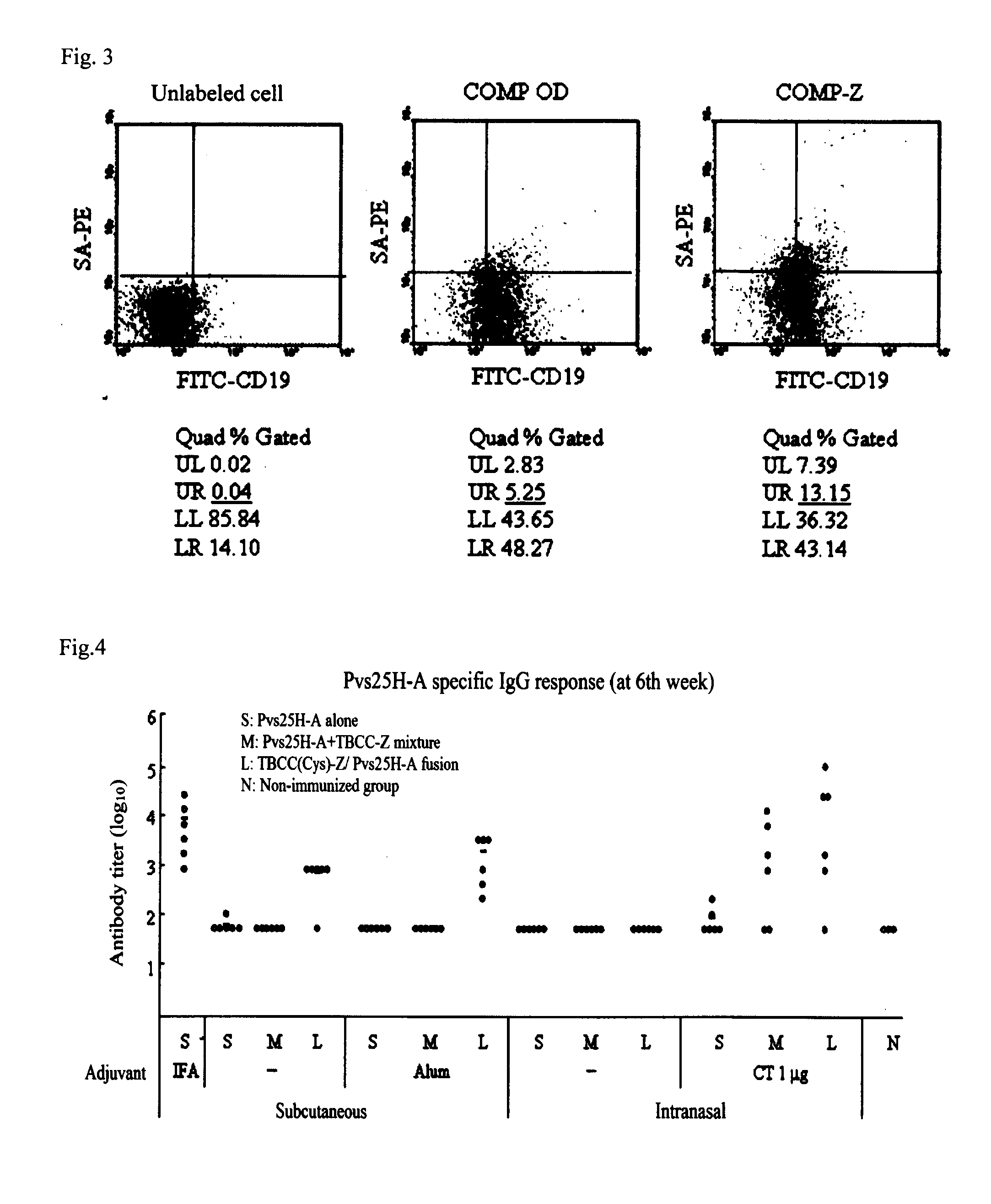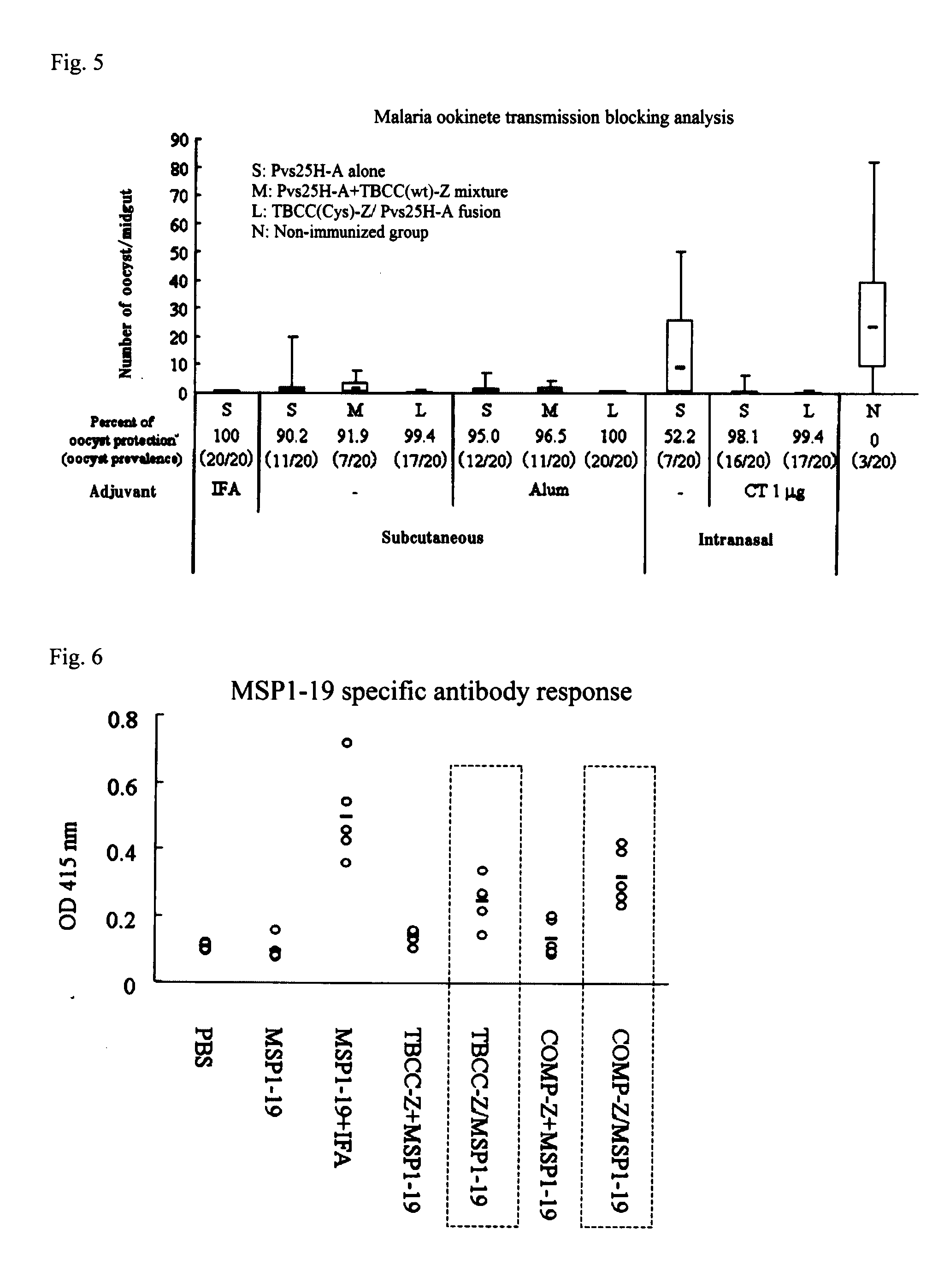Drug transporter, and adjuvant and vaccine each utilizing same
a technology of drug transporter and adjuvant, which is applied in the direction of carrier-bound antigen/hapten ingredients, immunological disorders, antibody medical ingredients, etc., can solve the problems of insufficient effect, inability to transport an antigen site, and reduced immunogenicity of highly purified recombinant proteins, etc., to enhance vaccine's immunogenicity or the immunopotentiating effect of adjuvant, high flexibility in design, and high versatility
- Summary
- Abstract
- Description
- Claims
- Application Information
AI Technical Summary
Benefits of technology
Problems solved by technology
Method used
Image
Examples
example 1
Production of COMP-Z Delivery Vehicle
(Cloning of COMP OD)
[0045]The following method was employed to clone the oligomerization domain (oligomerization domain: OD) of COMP. Thus, in order to obtain a product having the amino acid sequence of (G4S)3 added as a spacer sequence to 55 amino acid residues of COMP OD (SEQ ID NO:5), a sense primer SEQ ID NO:12 and an antisense primer SEQ ID NO:13 were produced, annealed and then introduced into a pCR2.1 vector, whereby accomplishing a subcloning.
[0046]After completion of the subcloning of COMP OD, the base sequence was verified, and a sense primer SEQ ID NO:14 and an antisense primer SEQ ID NO:15 were employed to amplify a COMP OD gene by a PCR, followed by digestion with restriction enzymes NcoI and XhoI, followed by subcloning into an E. coli expression vector pET-22b at the NcoI-XhoI site, followed by an ordinary calcium phosphate method to transform into an E. coli DH5 alpha. Then a screening on the basis of ampicillin as a drug resistan...
example 2
Production of Vaccine-Delivery Vehicle Fusion Complex (1):
[0058]Pvs25 which is a transmission blocking antigen of the Plasmodium vivax was fused with COMP-Z chemically utilizing an SH group present in COMP-Z. The vaccine antigen Pvs25 employed was a Pvs25H A form (Pvs25H-A) having a uniform conformation expressed in a yeast Pichia pastoris. As a crosslinker required for the fusion, an SPDP was employed and the following reaction schemes were employed to establish a fusion complex COMP-Z / Pvs25H-A.
[0059]The fusion was conducted using a COMP-Z pentamer (1 mg; 373 μl; 13,793 pmol), Pvs25H-A (2.84 mg; 499 μl; 137,864.08 pmol) (the molecular weight of COMP-Z was 72.5 kDa, the molecular weight of Pvs25H-A was 20.6 kDa, and COMP-Z to Pvs25H-A was 1 mol to 10 mol).
(Reducing Treatment)
[0060]First, a reducing treatment was conducted for ensuring an SH group in a reduced form in COMP-Z. While COMP-Z has an SH group in a reduced form even when being expressed in an E. coli, the number of availab...
example 3
Immunogenicity Verification Test:
[0065]30 μg of Pvs25H-A (S) was administered 3 times (0, 2nd and 4th week) to a 7-week old female Balb / c mouse (Nippon SLC) subcutaneously (s.c.), intraperitoneally (i.p.), intravenously (i.v.), and intranasally (i.n.) (n=7, except for the intravenous administration group where n=2). Similarly, a sample (M) which was a mixture of 30 μg of Pvs25H-A and 10.6 μg of COMP-Z, and 40.6 μg of COMP-Z / Pvs25H-A (L) obtained in Example 2 were administered. In addition, 1 μg of a cholera toxin (CT:LBL) and Samples S, L and M adjusted to 30 μg per Pvs25H-A were given intranasally (i.n. / CT). Moreover, a mixture of Freund's adjuvant (IFA) in a volume equal to the volume of antigen administered (which is herein 100 μl) and 30 μg of Sample S was given subcutaneously. Furthermore, in the absence of IFA, S, M and L adjusted to 30 μg per Pvs25H-A were given subcutaneously. In the 1st, 3rd and 5th week, a partial blood collection was made to verify an increase in the anti...
PUM
| Property | Measurement | Unit |
|---|---|---|
| heat resistance | aaaaa | aaaaa |
| concentration | aaaaa | aaaaa |
| molecular weight | aaaaa | aaaaa |
Abstract
Description
Claims
Application Information
 Login to View More
Login to View More - R&D
- Intellectual Property
- Life Sciences
- Materials
- Tech Scout
- Unparalleled Data Quality
- Higher Quality Content
- 60% Fewer Hallucinations
Browse by: Latest US Patents, China's latest patents, Technical Efficacy Thesaurus, Application Domain, Technology Topic, Popular Technical Reports.
© 2025 PatSnap. All rights reserved.Legal|Privacy policy|Modern Slavery Act Transparency Statement|Sitemap|About US| Contact US: help@patsnap.com



